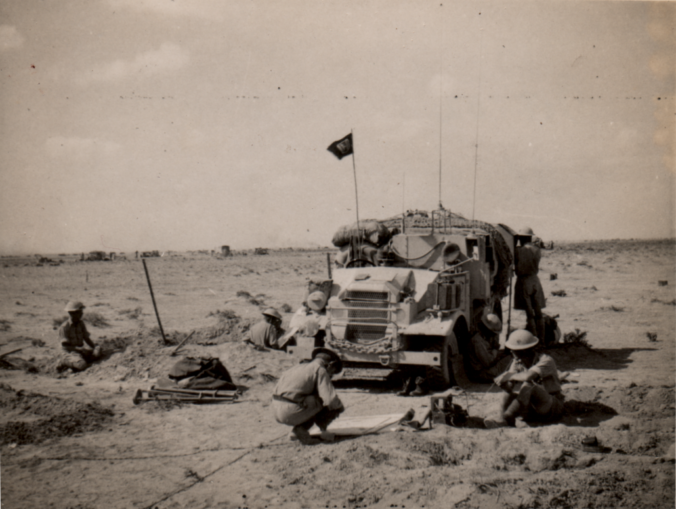
Previously unpublished photo courtesy of DJM’s uncle David, © 2020
More of the same is the best description of November. The Italians got their butts kicked both in and finally out of Greece resulting in the Duce eventually having to grovel to the Führer and beg for help from the Wehrmacht. I know Greece is not really part of the Desert War but our participation in Greece had an impact on what happened in North Africa. The convoys to Malta continued and the Italian fleet was famously attacked in Taranto harbour by some old Stringbags as the Swordfish were affectionately known.
So far there has been little in these articles about Malta under assault from the Italians. After some investigating it rather looks like Malta was the key to the eventual victory in the desert. Without the little island we would have had little chance of stopping most of the supplies reaching the Axis in North Africa. Once Rommel was there they could have reached the Nile with ease and started to move round towards Russia in line with Adolf’s drive to the east (Drang nach Osten). At the start of the conflict Malta had 4 Sea Gladiators for air defence, made famous as Faith Hope and Charity later on (one was destroyed). It was purely luck they had been left behind by a carrier sent urgently to Norway.
The reason we had no air defence on the island was our theory that the French Navy would save us from the Italian Navy, this doesn’t explain who or what would protect us from Italians in the air. The French Navy was now under the control of Vichy France. Never trust in or rely on the frogs under any circumstances. The Italian Air Force started bombing Malta on the 10th June, there were 8 separate raids that day. The Sea Gladiators did their best, they were slower (only 250 mph) and less heavily armed but much more manoeuvrable than the Italian planes. The first raid had no fighter escort but the following ones did. The Italians convinced themselves that Malta was defended by many more than 3 out of date biplanes. Had they launched an invasion during the first week or two, Malta would have fallen. It was the 28th before a few more Hurricane IIs arrived to bolster the defence but they were stretched to the limit.
It is fair to say that the Malta based planes had no time to intercept convoys at this stage, that came much later. They were flat out trying to stop the bombers and their escorts. The Royal Navy and a few planes started attacking convoys in early 1941. Additional planes arrived in dribs and drabs but never amounted to enough to take the fight to the Axis until 1942 when the USS Wasp took 50 or so Spitfires at a time to the vicinity of Algiers and then launched the planes so they could fly to Malta. The British carriers were much smaller and could deliver less than 20 planes.
Now let’s take a look at what was going on in Greece and it wasn’t good news for the Italians at all. On the 9th the commander of Italian operations in northern Greece, Sebastiano Visconti Prasca, was fired by Graziani and replaced by General Ubaldo Soddu (sic). The Greeks counter-attacked the stalled Italian invasion and pushed them back towards Albania. By the 13th most Italian troops were back at the Albanian border. On the 14th the Greeks advanced into Albania. On the 16th The Greek 3rd Army went through the Italian 9th Army’s defences at Korcë and 4,230 British troops along with 700 trucks and associated supplies landed at Piraeus.
On the 12th Hitler issued two more Directives, No 18 to the German Navy ordering it to take , amongst others, Gibraltar then one to the Wehrmacht to be prepared to invade Greece so the Luftwaffe could attack airfields from which the RAF would be able to attack the oilfields of Romania. Hitler had a big thing about the Romanian oil fields, they were just about his only supply.
On the 19th the Italians were pushed back across the River Kalamas in northern Greece, to the south cruiser HMS York arrived at Suda Bay bringing another battalion of British troops to Crete. On the 21st the Greeks captured the Italian 9th Army and Koritza in Albania. They took 2,000 prisoners, 135 field guns and 600 machine guns. The rest of the 9th Army escaped by virtue of being able to move faster than the Greeks who had little in the way of transport. By the 22nd the Italian 9th Army had been defeated in Greece. Now the Greeks could go for the throat in Albania but for the next week or so they caught their breath ready to start on the Italians again.
On the 10th a Martin Maryland, these planes had been handed over by the French to us just as France fell, flying from Malta in dreadful weather made two low level passes over the port of Taranto. The pilot, FO Adrian Warburton recorded the names of 5 battleships, 14 cruisers and 27 destroyers along with their exact locations. He flew so low that a ship’s radio aerial was hanging from his tailwheel when he landed. The following day he repeated the mission and the photos were passed to the Swordfish crews on HMS Illustrious.
That same day, the 11th, 21 Swordfish took off from Illustrious and at 11pm they flew over Taranto port. 11 of planes attacked the Italian warships with torpedos, the other 10 attacked the inner harbour. Two Swordfish were shot down with two of the four crew members being killed, the other 19 returned to the Illustrious. On the 12th 3 of the battleships skulked off to Naples with cruiser escorts to avoid a second attack which the British had planned but could not launch because of the bad weather. This one raid had knocked out half the Italian warships.
Meanwhile the convoys to Malta and Greece continued. On the 4th convoys AN6 and MW3 set out from Port Said and Alexandria for the Aegean and Malta. The ships were escorted by two anti-aircraft cruisers and four destroyers. On the 10th ME3 departed Malta with several empty ships but was spotted by Italian submarine Topazio. The Topazio tried to attack but all its torpedos missed. On the 11th another convoy assembled specifically to coincide with the attack on Taranto reached Malta. I think the E and W in the convoy names refers to the direction of travel so the N in AN6 also makes sense because it was heading northwards. This theory will break down later in the saga.
On the 15th the aforementioned 4,230 troops and 700 trucks left Alexandria for Piraeus. On the 17th HMS Argus launched 12 Hurricanes and 2 Skuas for Malta. Six of the Hurricanes were ditched at sea and one of the Skuas got lost and crash landed in Sicily.
On the 24th came Operation Collar, convoy ME4 with 3 merchant ships and a powerful escort left Gibraltar for Malta. On the 26th in an attempt to confuse the Italians, HMS Illustrious raided the seaplane base in Port Laki on Leros but the Italians did not fall for it and launched their own powerful fleet westwards to intercept the convoy.
On the 27th came the Battle of Spartivento. At 10am spotter aircraft from Force H, the escort for ME4, found the Italian ships and both forces soon clashed. The British were initially out gunned but at 11:30 am battleship HMS Ramilles and cruisers HMS Berwick and Newcastle arrived to even things up. Italian Admiral Campioni, under orders to only engage if his forces were superior, began to withdraw at 12:30. The British did not pursue, losses were about even, one ship hit on each side.
Force H then handed responsibility for convoy ME4 to the British Mediterranean Fleet. Two of the merchant ships docked at Malta and the third went on to Alexandria. At the start of December the Admiral of the Fleet arrived in Gibraltar for a Court of Enquiry into why Force H did not engage the enemy as they made their way back to Italy. Royal Navy ships were expected to be aggressive at all times.
There were more attacks on Libya, on the 10th Sidi Barrani was shelled from the sea and on the 24th and 26th Swordfish from HMS Eagle attacked Tripoli Harbour.
On the 29th General Freyberg, himself a kiwi, with his British and NZ troops occupied Crete. What would Jacinda think of all this and the NZ troops were reckoned to be among the best in North Africa.
In other news …. on the 1st 50 Italian planes attacked Harwich, of the 10 bombers the RAF claimed 8 as destroyed, this led to Italy’s decision to withdraw from the continuing bombing campaign against Britain a few weeks later, on the 3rd London had its first bomb free night in 57 days, on the 4th Hitler met with his top military leaders to discuss attacking Gibraltar, the Azores, Madeira and Portugal as a way to stop the Royal Navy entering the Mediterranean, on the 7th another blue on blue but this time it was us, HMS Encounter, a destroyer, rammed HMS Utmost, a submarine, but the sub managed to get to Gibraltar, on the 8th RAF Takali on Malta was officially operational, on the 12th Hitler issued another of his famous directives, this time it ordered the capture of Gibraltar, the Azores, Madeira and Portugal (he must have been absolutely barking by this time) and finally on the 25th the Mosquito took to the air for the first time at de Haviland’s factory in Hatfield and on the same day there was yet another unsuccessful attack on the Tirpitz.
With a top speed of 143 mph and a range of just over 500 miles the Royal Navy was getting more than its money’s worth out of those Swordfish, their unit cost was £5,500 in 1936, about £380,000 in today’s devalued currency.
Next month the deception work begins in earnest. We had already been using screens to cover real tanks and positioning dummy tanks to make the Italians think our forces were larger than they were and to cover up their real locations but the subsequent deception work would be much more involved.
© well_chuffed 2020
The Goodnight Vienna Audio file
Audio Player



